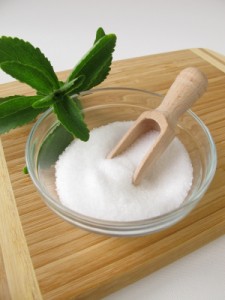 Stevia – also known as sweet leaf – is the hot all-natural sweetener of the moment. Of course, it’s been used as a natural sweetener for thousands of years in its native Peru, but only recently has it caught on with modern fans elsewhere in the world. With a negligible caloric impact, no glycemic impact, and a taste that can be up to 300 times sweeter than sugar, it’s being hailed as the perfect replacement for traditional sugar and artificial sweeteners.
Stevia – also known as sweet leaf – is the hot all-natural sweetener of the moment. Of course, it’s been used as a natural sweetener for thousands of years in its native Peru, but only recently has it caught on with modern fans elsewhere in the world. With a negligible caloric impact, no glycemic impact, and a taste that can be up to 300 times sweeter than sugar, it’s being hailed as the perfect replacement for traditional sugar and artificial sweeteners.
There’s just one problem – it’s not an exact replacement for any other chemical or natural sweetener. Stevia has its own unique taste and properties. While you can definitely use it to get a sugar-free sweet kick to almost anything, there are ways to use stevia that help you get more mileage and a better overall taste profile.
Remember it’s not 1:1 with sugar
A big mistake many people make when they start with stevia is assuming it’s a 1:1 match for sugar. They swap two spoons of sugar for their coffee for two spoons of stevia – and end up pouring the whole sickeningly sweet mess down the sink.
Stevia leaves, powders, and syrups all have a different sweetness profile. It can be 60 to 100 times sweeter than the equivalent amount of sugar. Thus, if you want to try sweetening with stevia, do it a very little at a time to get the level of sweetness you want.
Make up the volume difference
If you want to bake with stevia, you have a volume difference to manage. One cup of sugar may be replaced with as little as ¼ tsp of concentrated stevia powder, which throws off your ratio of liquids to solids, fats, and oils. This can make for some funny-looking cakes, cookies, and pies, so you’ll want to make up the bulk with unsweetened fiber to keep your recipe in balance.
124 Raw Food Recipes for Energy Bars, Smoothies, and Other Snacks to Supercharge Your Body
An easy unsweetened fiber choice you can make at home is unsweetened apple fiber. To get it, take applesauce and put it in a fine strainer, leaving the liquid to drain out overnight. The next day you’ll have a bulking agent with almost no flavor to help you balance your stevia in baking (and some super-sweet apple juice for a snack).
Remember there’s no melting or fermenting
Sugar does two things in dishes stevia won’t – it will melt down into a liquid at relatively low heat, and it will feed yeast to raise your dough. Stevia, on the other hand, doesn’t liquefy until it hits more than 400 degrees, and it can sit side by side with yeast for years before anything happens.
In some cases, you can compensate by adding 10 percent more liquid than the recipe originally calls for when there’s not much sugar in the dish to start or you have a 1:1 sugar-stevia powder mix. For yeasts, there aren’t as many options, and you’ll either have to choose a new recipe or find another way to sweeten the dish.
Blend with strong flavors for better results
Stevia on its own has a distinct flavor. Some say it’s a sweet touch of licorice, many feel it’s a bit “planty” in the food, and still others insist that the sweetener is bitter. Your impressions may vary, but one way to control the impression stevia makes is to use it in dishes that already have a very strong flavor. Mild teas and dishes with a light flavor profile let the stevia show through as the star, but cherry pies, dark chocolate cakes, or intensely flavored drinks won’t be much altered by a bit of stevia replacing the sugar.
These tips for sweetening with stevia will help you get started with this sugar replacement. No, it’s not an exact substitute, but you can get a lot of sweet without a lot of the side effects of traditional sugar or chemical additives. If you’ve been using stevia regularly or have more tips to share, please post them in the comments below so that everyone curious about stevia can have the chance to make the most of this alternative sweetener.
©2012 Off the Grid News
 Off The Grid News Better Ideas For Off The Grid Living
Off The Grid News Better Ideas For Off The Grid Living




